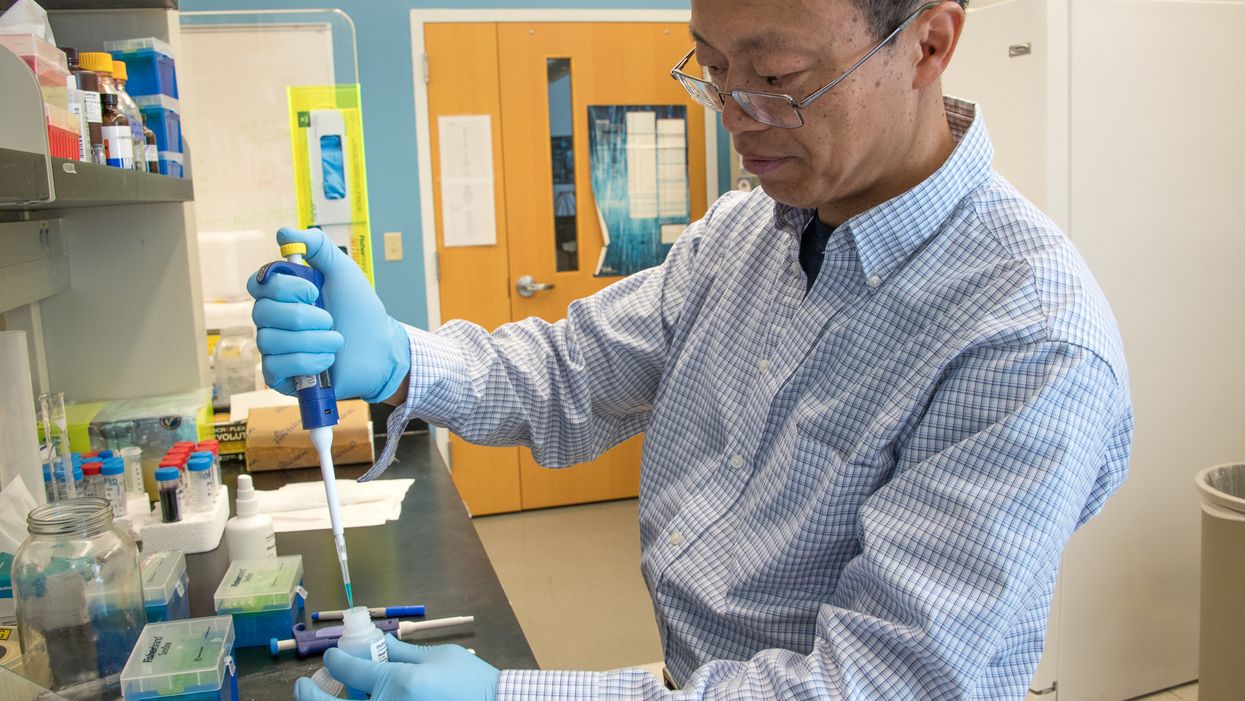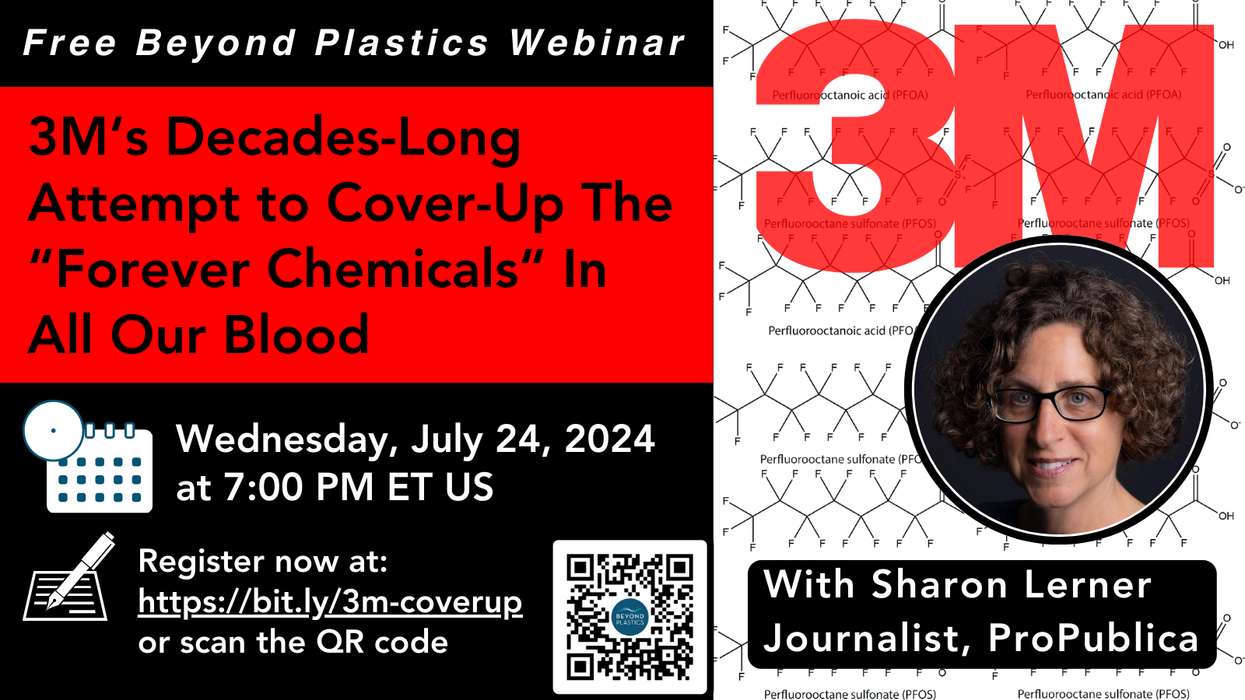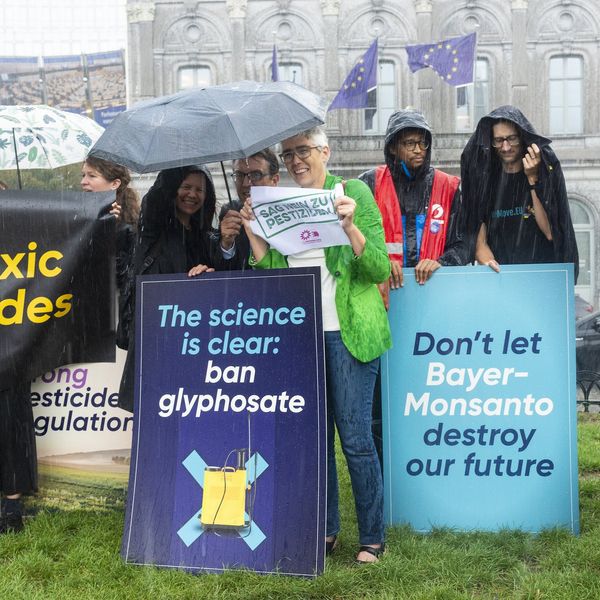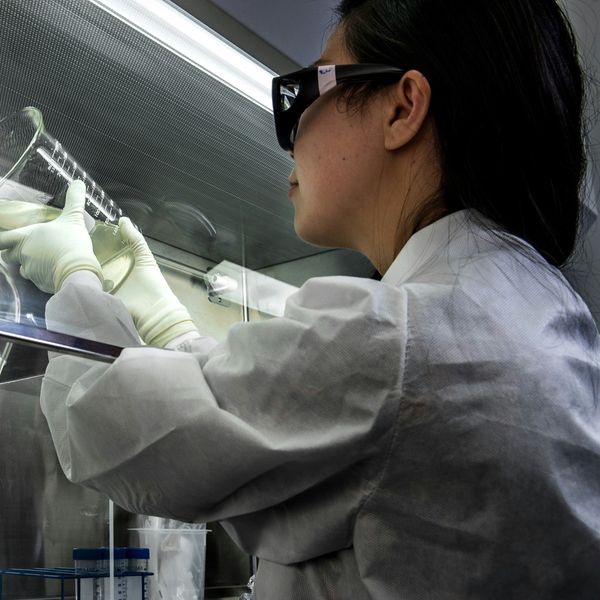This is part 1 of a 4-part investigation of the science surrounding the chemical BPA and the U.S. regulatory push to discredit independent evidence of harm while favoring pro-industry science despite significant shortcomings.
SEATTLE — Bisphenol A is likely coursing through your body right now. Every day, you're inadvertently consuming and absorbing trace amounts as it migrates from can and bottle linings into your food and drink, and from thermal paper receipts onto your skin.
Scientists have found BPA in more than 90 percent of Americans tested. Yet whether exposures to such small amounts of the common chemical pose any real health hazard remains highly controversial. On one side of a deep rift are academics who are adamant about the adverse effects; on the other side are U.S. Food and Drug Administration scientists who declare there are no dangers. Only one side has any control over what actually makes its way into your body.
"This is a chasm that is not going to be breached," Daniel Doerge, a biochemical toxicologist with the FDA for nearly 30 years, said during a panel at the European Food Safety Authority (EFSA) conference in Parma, Italy, last September.
Doerge and other federal scientists were attending the conference to share details of an unprecedented multimillion-dollar project co-led by the FDA, the Consortium Linking Academic and Regulatory Insights on BPA Toxicity, or Clarity for short. The effort aims to settle the long-standing dispute between government and academic scientists over the health effects of BPA.
Yet Doerge's words did not indicate any hope for such a reconciliation. He wore a green polo shirt, dark glasses and a grey mustache. And he exuded frustration — if not also a bit of arrogance — as he spoke. "Tribal dynamics," he said, are at play among the academics. Doerge alleged they were creating their "own narrative," and "staying in a bubble that turns into an echo chamber."
The struggle has been fermenting below the surface for years: Academics with modern methods and a sophisticated understanding of human physiology versus government and industry scientists who lean on decades-old established science in their evaluation of industrial chemicals. The suite of traditional toxicology tests recommended by the FDA for assessing a chemical's health risks hasn't been meaningfully updated since the early 1980s, before Doerge took his job and well before scientists began to understand how minuscule concentrations of certain chemicals common in consumer products, such as BPA, could mimic and mess with hormones in the body.
Scientists have long known that a tiny change in a natural hormone concentration — the equivalent of one drop of water in 20 Olympic-sized swimming pools — is enough to trigger instructions via the human endocrine system that impact growth, metabolism, sleep, reproduction and other critical functions of the body.
Related: See our comic strip version of this story, "Clouded in Clarity"
BPA is just the tip of the iceberg. Tens of thousands of manufactured chemicals are on the market; hundreds are believed to be endocrine disruptors — capable of scrambling hormone signals and, therefore, raising risks of health problems such as cancer, diabetes, obesity, infertility and behavioral problems. Other pervasive hormone imposters include phthalates, which are found in plastic food containers and personal care products, and per- and polyfluoroalkyl substances (PFAS), which are added to nonstick cookware and other goods to repel oil and water. Also on the list are flame retardants and pesticides such as DDT, glyphosate and chlorpyrifos. Even bisphenol S and dozens of other BPA replacements have been found to tinker with hormones.
Yet the FDA has remained reluctant to accept new science and independent evidence of harm. While the agency clings to the claim that BPA poses no health risks in the amounts it is used, thousands of peer-reviewed studies from academics suggest otherwise: Absorbing or ingesting the ubiquitous chemical may harm people at doses 20,000 times lower than what the FDA says is safe, comparable to levels at which most of us are exposed.
Even back in 1982, a scientific committee established by the FDA had warned of the potential for very low concentrations of chemicals to bind to hormone receptors and that technology in the future might find this interference alters the endocrine system's influential messages. The agency continues to miss opportunities to keep pace with scientific developments, noted Maricel Maffini, an independent consultant based in Germantown, Maryland. Instead, she told EHN, they primarily rely on tests devised decades ago that aren't designed to detect some significant effects that chemicals can have on our health.
If we followed the academics' science, BPA and its close relatives would effectively have to be banned, not reduced, in order to protect our health. "Really, if you look at the data, we shouldn't be making these compounds, period," Terrence Collins, a green chemist at Carnegie Mellon University, told EHN.
An investigation by EHN has uncovered a pattern of dissonance between academic scientists and federal agencies, as well as between the agencies themselves, regarding the evaluation and regulation of BPA and other endocrine disruptors. No one smoking gun surfaced. Yet putting together all the pieces creates a persuasive picture of willful blindness. Based on hundreds of emails obtained via Freedom of Information Act requests — along with dozens of studies and reports, and more than 50 conversations with scientists, regulators and other stakeholders — evidence suggests that regulators may be operating at the fringes of scientific integrity, possibly with the intent to keep the current testing and regulatory regime intact and to avoid scrutiny. EHN's findings include:
●Insistence by the FDA on a study design that limited Clarity's robustness to reveal health effects, including the use of a strain of animal that had been shown to be insensitive to hormone disruptors, the choice of a stressful means to deliver BPA to the animals, and the allocation of small numbers of animals provided to some of the participating academic scientists.
●Potential BPA contamination of the control animals, which may have further masked true differences in health effects between control animals and animals receiving administered doses of BPA.
●Statistical approaches in the government's side of Clarity, a traditional regulatory toxicology study dubbed the Core Study, that set a high bar to detect differences and disregarded patterns in the data that did not fit outdated assumptions on the relationship between a dose of an endocrine-disrupting chemical and its health effects.
●Framing of the government's Clarity Core Study draft report and corresponding press release that downplayed the health effects that did emerge in the data.
●Hints of potential industry influence, such as the FDA's reliance on industry-funded studies.
Clarity, the intended remedy for the government-academics impasse, was launched in 2012 by the FDA, the National Institute of Environmental Health Sciences (NIEHS) and the National Toxicology Program (NTP). The effort combines a traditional regulatory toxicology study from the government and investigational studies from academics.
The FDA took the lead on raising and treating the study animals and on performing the Core Study, which was published under the auspices of the NTP. The NIEHS awarded grants to participating academics and worked with the NTP to coordinate the study. The government and most of the 14 participating academic scientists completed their respective studies for the collaborative project in the months preceding the September 2018 EFSA conference in Italy.
Everyone used the same breed of lab rats, and followed government-approved standards as they investigated possible health impacts. To prevent bias, all Clarity scientists were blinded to the BPA exposure levels of the animals and tissues that they received for study.
Earlier in the Italy meeting, Doerge and his federal colleagues presented the government's Core Study. Once again, they relayed results that they said generally absolved BPA. They did not discuss findings from the participating academics. In fact, during the panel, Doerge seems to dismiss those studies, many of which challenged BPA's safety. "I don't see a lot of advantages in, so far anyway, in what the extramural research funding initiative has brought into the Clarity project," he said. (The FDA did not make Doerge available for an interview.)
Sitting in the audience in Italy was Heather Patisaul, a biologist at North Carolina State University and one of the academics participating in the massive BPA study. "I was screaming in my chair," she told EHN. "He said it so smugly."
An integrated report that pulls all of the Clarity studies together is underway, co-authored by the FDA and other participants. John Bucher, a senior scientist with NTP and NIEHS, told EHN that he expects the report to be completed by the end of this year. It will then be up to the FDA whether or not those results will spur any reshaping of U.S. regulations.
Several of the academic scientists are concurrently working on their own independent review of the Clarity data. Cheryl Rosenfeld, a biologist at the University of Missouri and another Clarity investigator, is among the co-authors on that report. "Many of us are not happy with the FDA," she told EHN, adding that she and others are skeptical of what will end up in the official integrated report and if it will have any impact on policy.
In the U.S., what the government considers a safe exposure level for BPA — 50 micrograms of BPA per day per kilogram of body weight — has remained untouched for more than 30 years, leaving us all exposed daily to the chemical. Meanwhile, other countries represented at the EFSA meeting have begun reaching agreements and acting on BPA.
France has enacted the strictest regulations, banning the use of the chemical in all food and beverage packaging and utensils after an assessment by the French Agency for Food, Environmental Health and Safety determined that it is hazardous at much lower doses than the FDA considers hazardous. A Danish Food Institute Clarity-like study, too, recognized effects at low doses.
Many more countries are keeping a close eye on Clarity. EFSA, which is funded by the European Union to conduct risk assessment but not to create policy, told EHN that it will consider the results as part of its ongoing evaluation of BPA. In January 2015, based on the latest information, EFSA dropped its safety limit from 50 to 4 micrograms of BPA per day per kilogram of body weight.
The scientific, economic and political stakes are high. For decades, modern commerce across the Western world has depended on BPA. The chemical is used in the production of goods that pervade our lives: reusable water bottles, food containers, canned goods, store receipts, medical devices and dental sealants. And despite growing concerns, the manufacturing of BPA remains on the rise. The global BPA market is increasing about 3 percent per year, and is projected to reach $22.5 billion by 2022 and top 7 million tons by the end of 2023.
"BPA is very cheap to make," said Collins. "I believe the regulatory bodies of the country are locked up by the monetary implications of addressing endocrine disruption."
While the clash continues over how endocrine-disrupting chemicals are tested and thereby regulated, irreversible changes to our bodies and health may be happening now. Collins pointed to declining sperm counts and rising rates of endometriosis, which he suggested could be a consequence of these exposures given that the chemicals have been shown to induce such effects in animals.

University of Massachusetts-Amherst environmental health scientist Laura Vandenberg. (Credit: Umass.edu)
"Endocrine disruptors are harming people and we're not regulating them to any extent right now," Carol Kwiatkowski, executive director of The Endocrine Disruption Exchange, a nonprofit research institute that advocates against the production and use of chemicals that interfere with healthy hormone function, told EHN.
"A lot of endocrine scientists have been banging their heads against that wall for a long time and haven't made any progress in changing the risk assessment process."
It is clear that the FDA is not using modern science in protecting the public from potentially toxic chemicals. It is also clear that BPA and other endocrine disruptors threaten to disrupt the status quo of toxic chemical regulation. "BPA creates a tipping point," Laura Vandenberg, an environmental health researcher at the University of Massachusetts-Amherst's School of Public Health, told EHN. "If the FDA finds out that they have been wrong about BPA — or wrong about how they evaluate chemicals for safety — that means they are wrong about the 10,000 other chemicals behind BPA in line for the same sort of evaluation."
Vandenberg, who is not involved in Clarity, is among scientists skeptical that the groundbreaking effort will result in a fair assessment of BPA. The FDA, she said, has "a vested interest in not being wrong."
Imposter's poster child
In the 1930s, a British medical researcher discovered that BPA could mimic the activity of estrogen — a female sex hormone — in the human body. The chemical was briefly considered for use as a pharmacological hormone but ultimately lost to another synthetic estrogen, diethylstilbestrol (DES). While DES was prescribed to millions of pregnant women over the next 30 years before its own health risks became known, BPA was never turned into a drug.
Its future would instead be in the chemical industry.

Cheryl Rosenfeld, a biologist at the University of Missouri and another Clarity investigator. (Credit: University of Missouri)
Beginning in the 1950s, BPA became a key ingredient in polycarbonate plastic and epoxy resins — finding its way into everything from Tupperware to the lining of food cans. "That's where the problem starts," Ana Soto, an endocrinologist at Tufts University and another Clarity investigator, told EHN.
The FDA officially approved BPA for use in food and beverage containers in 1963. They classified it as a "generally regarded as safe" (GRAS) compound, since it had already been around for a few years and there was no obvious evidence of harm. By the late 1980s, the U.S was producing nearly a billion pounds of BPA a year. Even scientific laboratories began working with BPA-laden instruments. In 1993, endocrinologists at Stanford University discovered that BPA was leaching from polycarbonate flasks in their laboratory.
The first published studies to raise concern about BPA's low-dose health effects came a few years later, in 1997. Frederick vom Saal and his colleagues had found exposure to tiny amounts of BPA altered the prostates and reproductive systems of laboratory mice. Vom Saal, a professor of biology at the University of Missouri-Columbia and another Clarity investigator, warned viewers in a February 1998 episode of PBS's Frontline about the threat posed by endocrine-disrupting chemicals used in plastics and other consumer products.
"We understand now, with new techniques, that, in fact, cells are extremely responsive to these chemicals," vom Saal stated on the show. "What you have now is clearly enough scientific information to warrant concern and a change in the regulatory approach to these chemicals." Concern grew, as did the body of research.
By 2008, enough evidence had accumulated that the NTP labeled the chemical as possibly harmful for babies. Canada responded by declaring BPA toxic and manufacturers across North America, including baby bottle and sippy cup makers, started phasing it out of their products. Wal-Mart, REI, Lululemon, Toys-R-Us and other retailers, too, began pulling products with BPA off their shelves. The market was soon flooded with BPA-free products — although most of the substitutes that landed in stores share similar chemistry with BPA and pose similar health concerns.
"The science is growing exponentially. We can't keep up with it," said Kwiatkowski, of The Endocrine Disruption Exchange. "And we have to take it all very seriously, because the preponderance of endocrine-related disorders in humans today is just skyrocketing."
Pregnant women, infants and young children face the greatest risks, as a healthy functioning endocrine system is especially critical during development. "If you perturb it, it is not going to be reversible," Linda Birnbaum, former director of the NIEHS and the NTP, told EHN. "Whatever happens, it is done."
In-utero BPA exposure, for example, may derail the normal growth of the brain and other organs and manifest later in life as early puberty or an increase in anxiety-related behaviors or attention deficit hyperactivity disorder (ADHD).
And, again, BPA is just one of many chemical threats to our hormones. We are exposed daily to a cocktail of stuff suspected of altering our endocrine system. "When we talk about endocrine-disrupting chemicals, it might be that the real story is in the mixture," Chris Gennings, the director of biostatistics and an environmental medicine researcher at the Icahn School of Medicine at Mount Sinai in New York, told EHN. While the level of exposure to any single chemical might not surpass a safety threshold, she explained, "if you put all of them together, then the mixture can reach a level of concern."
It is not only the potential health consequences that are leading many scientists to urge a more substantial overhaul of the testing and oversight of endocrine-disrupting chemicals. There are economic concerns: In 2014, researchers conservatively estimated that just the cases of childhood obesity and adult heart disease attributable to BPA cost the U.S. $3 billion annually. A 2016 study that considered a few endocrine-disrupting chemicals and a few specific diseases calculated an annual $340 billion in U.S. health costs and lost wages — or about 2.3 percent of the GDP. (Editor's note: Pete Myers, CEO and chief scientist of Environmental Health Sciences, was a co-author on the paper. He is also the founder of EHN, though the publication is editorially independent.)
"This is an underestimate of an underestimate of an underestimate," Dr. Leonardo Trasande, a researcher at New York University, author of the book, Sicker, Fatter, Poorer, and an author on both studies, told EHN.
Trasande noted his initial hope that Clarity would result in "progress toward a consensus" on methods to evaluate BPA. But the FDA, he said, "has taken the approach that its science and its mindset are superior to that which has been published in peer-reviewed scientific literature."
Maurice Whelan, head of the Chemical Safety and Alternative Methods Unit of the Directorate for Health, Consumers and Reference Materials of the European Commission's Joint Research Center, shared similar thoughts while sitting next Doerge on the panel in Italy. Clarity was "institutionally biased," he said, with "the science strategy dictated" and a "very clear mindset about how to go about this."
Recipe for a poison
Core to the discord is a historical assumption about toxic chemicals. Nearly 500 years ago, Swiss physician and chemist Paracelsus coined an adage that would become a basic principle of toxicology: "The dose makes the poison." In other words, the higher the concentration of a toxic chemical, the more toxic it is.
The FDA generally assumes this increasing-dose-increasing-harm relationship in its evaluation of chemicals that come into contact with food, whether directly or indirectly through production, processing, packaging and distribution. A dose-response curve should therefore always be monotonic, according to the agency, meaning it will never change direction from positive to negative, or vice versa.
As a result, when the agency deems a dose of a chemical safe, their investigation has not necessarily tested health effects at that dose — or at any lower doses. Rather, industry and government scientists typically follow an efficient, seemingly common-sense method. They start by exposing lab animals to extremely high doses of the chemical, incrementally drop the doses until they no longer detect obvious harm, then cut that last number down by a margin of safety to create a conservatively "safe" exposure limit.
Endocrinologists, on the other hand, expect craziness in their data. At least for hormone-mimicking chemicals, a relatively high dose might prove innocuous while a far lower dose wreaks havoc on the body. And they've observed that different doses can cause different effects. Such a non-monotonic dose-response curve might take the shape of a "U" or a bell. Take, for example, a 1997 paper co-authored by vom Saal. At 200 nanograms of DES per gram of body weight per day, the prostates of the mice in his study were significantly smaller than prostates in the control mice and prostates in mice receiving other doses.
At a mid-range of 20 nanograms of DES, no effect was seen. And that, under traditional toxicology, is where regulators would stop testing. But drop the dose further, to 2.0, 0.2 and 0.02 nanograms, and vom Saal found prostates were significantly larger than prostates in all of the other animals. The resulting dose-response relationship resembled a bell.
"What we've learned from literally tens of thousands of papers, is that endocrine activity is stimulated by very tiny quantities of endocrine hormones," said Collins, the green chemist. "If you raise the concentrations, you turn the effect off."
His guess as to why: "Nature has decided it doesn't want to have an overreaction to an endocrine hormone."
Birnbaum compared the phenomenon to the body's response to vitamins and minerals, where "too little is a problem and too much is a problem." And scientists have identified potential biological mechanisms for non-monotonic dose-responses, such as opposing effects from multiple hormone receptors.
Still, others push back on the notion of non-monotonicity. "It's illogical. It flies in the face of every mechanism we know in science," Patrick McKnight, a measurement scientist at George Mason University in Fairfax, Virginia, told EHN. "In toxicology you really have to demonstrate that there's an effect of some sort, and I think a lot of these investigators are searching for these effects." (McKnight is on the advisory board at Sense About Science USA, formerly the Statistical Assessment Service, which has industry ties and a record of downplaying the dangers of products.)
Steven G. Hentges, senior director of the Polycarbonate/BPA Global Group at the American Chemistry Council, an industry trade group, stated that "experimental evidence" to support non-monotonic dose-response has been "limited." He pointed to a recent European review that supported that view. Of 179 datasets evaluated in the paper, the authors concluded that only 10 met criteria for a non-monotonic dose response. They acknowledged difficulty in identifying relevant studies and applied strict rules for inclusion in the review, including a requirement that studies include at least five dose groups. This is rare. Even guidelines for traditional regulatory toxicology studies recommend just three dose groups.
The FDA, meanwhile, has stuck to its guns, repeatedly dismissing data on low-dose effects or non-monotonicity. Marianna Naum, an FDA spokesperson, told EHN in an email that the FDA and other federal agencies have determined that non-monotonicity "is not often found in toxicology of the endocrine system," and that "current regulatory testing methods are sufficient" to pick it up. (EHN tried for months through multiple emails and phone calls to arrange a phone interview with someone at the FDA. The agency repeatedly ignored and denied those requests.)
The agency also has a history of brushing off study results because they did not fit its strict study criteria adopted in the 1980s to calculate doses of chemicals that are expected to be safe for humans. These traditional "guideline" studies, as they are called, follow validated "good laboratory practice" (or GLP) protocols. Together, the rigorous study guidelines and lab rules dictate the number and type of animal used, levels of exposure to the chemical of interest, the outcomes to evaluate and record-keeping methods, among other details. And these studies remain the evidence preferred by the FDA, because they "provide risk assessors and risk managers with reproducible results upon which science-based decisions and policy may be based," Naum stated in the email.
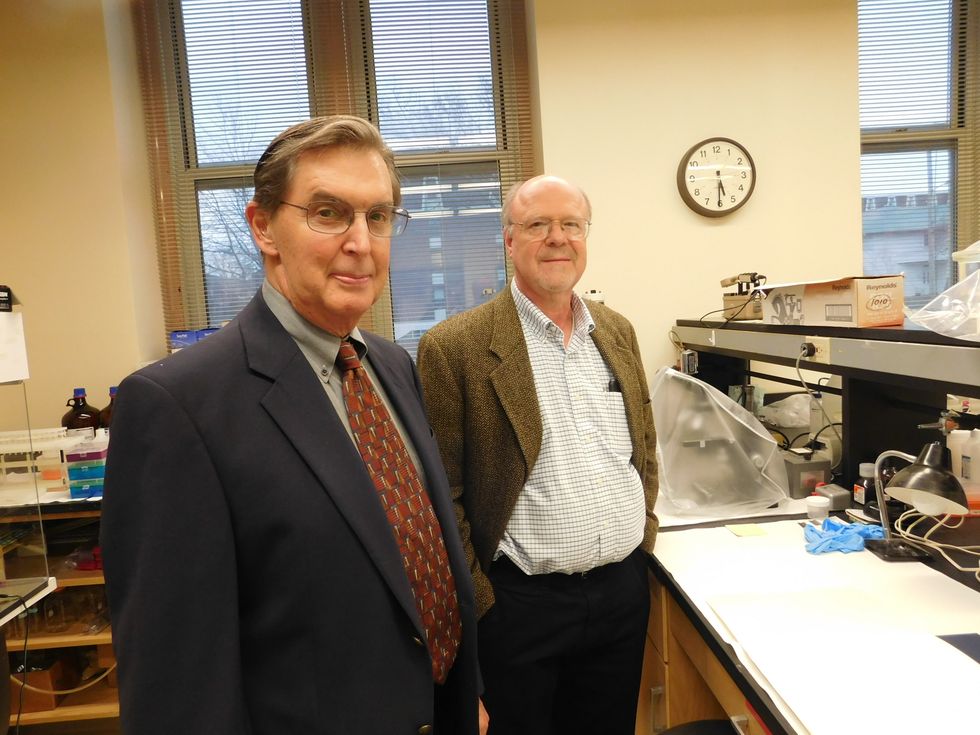
Researchers Fred vom Saal and Wade Welshons at their University of Missouri lab. (Credit: Brian Bienkowski)
Jennifer Sass, a senior scientist with the Natural Resources Defense Council, said that the guidelines are "a good starting point to see if there's evidence of harm," and "allow regulators from Japan to Sweden to North Africa to look at data the same way." However, she added, these guidelines "should not be used to eliminate evidence of harm."
Such standardized studies can also be pricey to conduct, often beyond the budgets of academics. And the FDA's traditional targets for tests, such as weighing organs and looking for other overt signs of toxicity, generally do not consider the unique effects of endocrine-disrupting chemicals — some of which can be subtle such as behavioral changes or infertility years down the road.
"You can't weigh a brain to find out what is going on in there," Soto said.
In 2001, the NTP appeared to agree. They concluded in a report that published studies had provided evidence for the effects of BPA exposure at or below the safety standard set by the FDA. And they recommended a reconsideration of the current testing paradigm.
The plastics industry pushed back, funding the Harvard Center for Risk Analysis, a group that had received financial support from chemical companies in the past, to do a separate review of the literature on BPA. That assessment determined that only two large studies—both funded by industry—were relevant and reliable enough to consider. Both studies would go on to make regular appearances in subsequent FDA reports.
Doerge was a co-author on FDA's most recent safety assessment of BPA, released in 2014, which reaffirmed its position that the chemical is safe at levels of exposure from food contact uses. "No new information was identified to suggest revision of the existing safety assessment level," wrote the authors.
The report was an update of the agency's 2008 assessment, for which the FDA relied heavily on the same two industry-funded guideline studies considered in the Harvard group's analysis and discarded hundreds of non-GLP studies published by academics that nonetheless found low-dose effects of BPA.
An external FDA committee had even reviewed the 2008 report and disagreed with the agency's decision to exclude those other peer-reviewed papers. "The draft FDA report does not articulate reasonable and appropriate scientific support for the criteria applied to select data for use in the assessment," they wrote. "Specifically, the Subcommittee does not agree that the large number of non-GLP studies should be excluded from use in the safety assessment."
Of note: A 2006 analysis found that 11 out of 11 industry-funded studies found BPA had no significant action, while 109 of 119 studies that had no industry funding did find effects of BPA.
Yet those industry-funded studies tend to use more expensive GLP protocols and qualify as guideline studies. "The non-guideline studies are basically ignored. To me, that's like wearing blinders," said Birnbaum. "Science has continued to advance, and I think there are questions that we really didn't know about 30, 40, 50 years back that people are asking today."
"If you don't ask the question, you're not going to get the answer," she added.
Jerry Heindel, the health scientist administrator at the National Institute for Environmental Health Sciences (NIEHS) when Clarity was initiated, agreed. "Maybe these guideline studies aren't as gold standard and terrific as people have thought," he told EHN. "Problem is, the endpoints are so simplistic and old-fashioned."
But he and other scientists also acknowledge that the FDA has an extremely high bar to justify adoption of new approaches, let alone bans on a chemical. Regulatory agencies are in a tight spot and have to first ensure they can't be sued, added Heindel, who retired from NIEHS in 2016 and founded Commonweal's Healthy Environment and Endocrine Disruptor Strategy (HEEDS), a hub for scientists working on endocrine disruptors. "If they come out and say a chemical is toxic and we need to ban it," he said, "then they have to feel confident they have the data that will stand up in the court of law."
Deepened divide

Gail Prins, a researcher at the University of Illinois at Chicago and Clarity investigator (right). (Credit: uic.edu)
On February 23, 2018, upon completion of the draft version of the government's Clarity Core Study, the FDA released a public statement, suggesting that the findings supported its position that "currently authorized uses of BPA continue to be safe for consumers."
The move stirred significant press, mostly reassurances to the public of the chemical's safety; FDA's collaborators were not pleased. Some suggested that the very agency responsible for ensuring our safety is actively working to avoid dealing with a massive experiment that is disrupting our hormones from birth.
"I smell a big fat rat here," Gail Prins, a researcher at the University of Illinois at Chicago and Clarity investigator, wrote in an email to Nigel Walker of NIEHS after learning of the statement. "The FDA is not playing fair."
Walker, a toxicologist who helped lead Clarity, responded by sending a scathing email to officials at the FDA. Members of that agency's upper management, he wrote, were "reneging on their own values in regulatory science," and "using the Clarity core study as a quasi-definitive human risk assessment document to affirm the current FDA policy on safety of BPA." In additional emails obtained by EHN, Walker went on over subsequent days to write of FDA officials' "shenanigans," calling their actions "disingenuous" and "disrespectful." He referred to himself as "peeved."
He also made a point to state that he had no conflicts of interest himself: "I don't have a horse in this race," wrote Walker.
The FDA declined to comment on the statement, or on the subsequent criticisms from collaborators. A culture clash of sorts continues between the FDA and NIEHS. Multiple scientists with the latter agency shared similar sentiments about the FDA's conduct in Clarity. Walker declined a phone interview but stated in an email to EHN that "there may from time to time be disagreements on various issues or topics."
Birnbaum said that while she was not surprised by the FDA's conclusions from the government's portion of Clarity — it was, after all, consistent with their historic stance on the chemical's safety — she did not share their opinion. "I think we reserve the right to disagree, respectfully," she said. And Bucher of the NIEHS and NTP offered his take: "The FDA conclusions are the FDA's view of how they look at data from these kinds of studies... To us, it would be more valuable to try to integrate this information and then come up with statements as to interpretations."
In September 2018, the government released the final version of its Core Study report. The FDA also advertised and hosted a webinar to detail their findings, which was preempted by outside academics who held their own webinar to present contrasting conclusions. The academic webinar was organized and moderated by Myers of Environmental Health Sciences.
Webinar: CLARITY-BPA: Achieving clarity on low dose effects of bisphenol A
As expected, the government's report stated that exposing rodents to BPA resulted in some health effects at high doses but not at the low doses to which people are generally exposed.
Hentges, of the ACC, praised the report. "The scope and magnitude of the FDA study are unprecedented for BPA, and the results clearly show that BPA has very little potential to cause health effects, even when people are exposed to it throughout their lives," he told EHN in an email. (The ACC declined multiple requests for a phone interview.)
But that is not exactly what the government's data said, even if that sentiment was reflected in the FDA's early press release.
"They have a bunch of data that says BPA is doing something. But they're ignoring that data," Patisaul, the North Carolina State University biologist and Clarity investigator, said.
This March, Vandenberg co-authored an opinion paper with two other scientists also not involved in Clarity, to see what data the feds may be missing. After a close look at the government's Core Study results, they identified 41 endpoints with statistically significant effects. As with the academics' studies, the lowest doses were associated with the greatest number of effects, such as mammary gland cancer, kidney damage, increased body weight and altered gene expression in the brain. "There are a lot more effects at low doses than high doses. A lot more," Vandenberg said. "It's hard to ignore that and say everything is fine here. Even the FDA's own data suggests there is harm."
During another session at last September's EFSA meeting in Italy, Barry Delclos, a biochemical toxicologist with the FDA, responded to a question from Patisaul regarding these low-dose results. He answered that his team had looked to see if "consistent responses" would explain the statistically significant results they had found. "We didn't feel that was the case," he said. Delclos also stated in the September 2018 webinar that his team questioned the biological significance of findings that didn't fit a consistent dose-response relationship.
The frustrations of academics and health advocates, as well as of FDA scientists, is tangible. Patisaul argued that Delclos, Doerge and their colleagues are in their "own echo chamber," doing the "same thing they are accusing everyone else of doing," and unwilling to recognize that their science might be outdated. Doerge went on during the EFSA panel discussion: "You come to someone that has all the responsibility mandated by law to protect the public from this or that, and you're saying, 'Oh, these basic tenets that you've used to do your job for all these years is no longer valid. Dose-response doesn't exist any longer,'" he said. "This is a fundamentally unbreachable barrier, in my opinion."
In the 1998 PBS interview, vom Saal detailed a "distinct pattern" that comes with any paradigm shift in science — especially one, he said, that could impact billions of dollars of profits for chemical companies. "The first thing is absolute denial," he said. "The second is a feeling that it may be true, but it's only true in very limited circumstances. The third is, it's true but the economic consequences are so great that we can't do anything about it."
Lisette van Vliet, a senior policy coordinator with Breast Cancer Prevention Partners, a San Francisco-based nonprofit, likened it to the times of Galileo. "A bunch of scientists were saying the Earth is the center of the universe; other scientists were saying the sun is the center," she told EHN. "They were using very different ways of ascertaining reality."
"These paradigm fights tend to be long and protracted and don't always have a complete 'aha' moment," said van Vliet. "The Clarity study was as good of a stab as anyone could make… The integrated final version of the study is going to be a really important point in this discussion, but it is not going to be the end of the story. And, meanwhile, public health will suffer because of continued exposure to this harmful chemical."
In part 2 of this series, EHN details how the FDA operates on the edge of research honesty, inconspicuously misleading the public with regard to the testing and regulation of BPA.
- BPA Pollution: What you need to know - EHN ›
- BPA exposure: Fight brews over how contaminated we really are - EHN ›
- European Food Safety Authority accused of minimizing some effects of endocrine disruptors ›
- REI to ban PFAS in outdoor clothing and cookware - EHN ›
- The most dangerous “sustainability dispositions” - EHN ›
- FDA under scrutiny: Policymakers, advocates respond to 'Exposed' BPA investigation - EHN ›
- Hormone-altering chemicals threaten our health, finances and future - EHN ›

